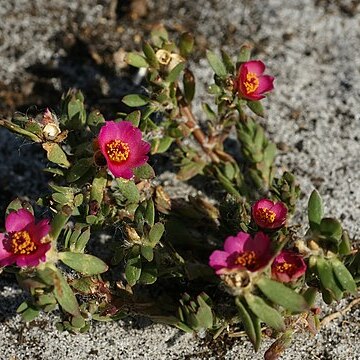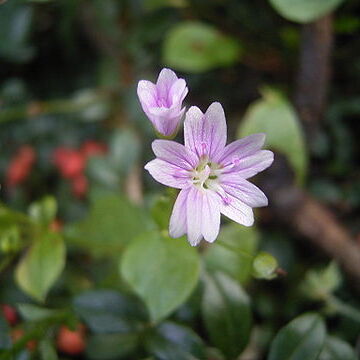Annual or perennial herbs, occasionally soft-wooded shrubs or small trees, usually with most parts rather succulent. Leaves opposite or alternate, simple, entire; nodal and axillary scales and/or hairs sometimes present. Inflorescence cymose, sometimes reduced to a solitary axillary flower, or congested into a raceme-like panicle or terminal head of sessile flowers surrounded by an involucre of leaf-like bracts. Flowers regular. Sepals 2, slightly unequal, the outer overlapping both margins of the inner, free or basally connate. Petals (3–)4–5(–12), free or basally connate, sometimes adnate to the ovary base, usually conspicuous but fugacious. Stamens 3–numerous, often adherent to the petals. Ovary superior or (in Portulaca) partly inferior, with 2–5 carpels, unilocular, placentation free-central or basal, ovules few to many; style simple; stigma capitate or branched. Fruit a capsule, circumscissile or dehiscing longitudinally, rarely indehiscent. Seeds 1 to many on long persistent funicles, black or brown with a pale aril (in Flora area), often glossy or with a metallic sheen, embryo curved, testa smooth or concentrically ornamented
Subshrubs [shrubs] or herbs, annual, biennial, or perennial, often succulent or fleshy. Leaves opposite, subopposite, or alternate and sometimes secund, sometimes rosulate or subrosulate, exstipulate (except Portulaca and Talinopsis, with nodal or axillary hairs regarded as stipular); blade margins mostly entire, occasionally dentate to crisped. Inflorescences axillary or terminal, cymose, racemose, paniculate, or umbellate, sometimes glomerate, spikelike, or with flowers solitary, open to congested. Flowers mostly radially symmetric, sometimes slightly irregular (in Montia); sepals 2-9; petals (1-)2-19 or sometimes absent, distinct or connate basally; stamens 1-many, opposite and sometimes basally adnate to petals; gynoecium 2-9-carpelled; ovary 1, superior (half-inferior to inferior in Portulaca), 1-locular throughout or initially plurilocular and becoming 1-locular distally (in Portulaca), placentation basal or free-central, ovules 1-many; style present, sometimes branched, or absent; stigmas 1-9. Fruits capsular. Seeds smooth or sculptured, with or without strophioles or elaiosomes. x = 4-9, 11, 13, 15, 23.
Ovary superior or half inferior, 1-locular or partially divided into several loculi near the base; placentation basal; ovules 1-?; style simple or variously divided
Leaves sessile or petiolate, opposite or alternate; stipules scarious or modified into many or few hair-like axillary appendages or absent
Herbs or undershrubs, often, succulent; leaves alternate or opposite, with scarious or setose stipular appendages
Ovary superior or half-inferior, 1-celled with basal placenta; ovules 1 to many; style usually variously divided
Fruit a capsule dehiscing by valves or by a transverse split (circumscissile), rarely a nut and indehiscent
Petals 4–6 (in all African genera), imbricate, free or connate up to half-way or more, often fugacious
Fruit a capsule dehiscing by longitudinal valves or circumscissile, very rarely an indehiscent nutlet
Flowers bisexual, actinomorphic, variously racemose, paniculate or cymose or solitary
Stamens as many as and opposite the petals or more numerous, free; anthers 2-celled
Flowers actinomorphic, hermaphrodite, solitary or variously cymose or racemose
Stamens as many as the petals or more numerous, free or adnate to the petals
Seeds globose-reniform; embryo surrounding the copious mealy endosperm
Petals 4–6, imbricate, free or connate at the base, soon falling
Annual or perennial herbs or shrubs, often succulent
Sepals 2, imbricate, free or united at the base
Sepals 2, imbricate, free or united at the base


